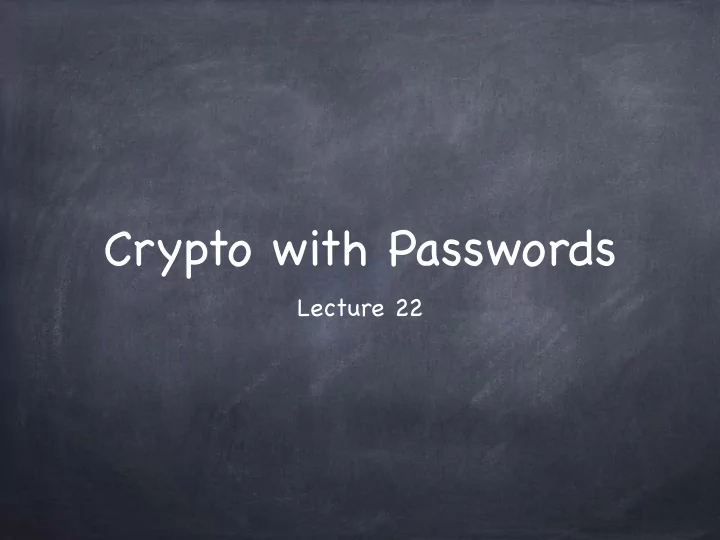

Crypto with Passwords Lecture 22
Passwords Password or passphrase: Low-entropy shared secret Typical goal: client authenticating to server, without being tied to a device holding a cryptographic key. On authentication, a session key should be set up. Also, often Mutual Authentication (if server/client can’ t/doesn’ t want to use certificates to verify server’ s authenticity) Cannot get “negligible” security error: password can be guessed with some significant probability Goal: allow only an online guessing (dictionary) attack. Prevent offline dictionary attacks. Even if server compromised, still somewhat protect the passwords, by allowing only a slow offline dictionary attack
Key from Password Common scenario: client only has a password rather than a key. Server has some information derived from client’ s password They will on-the-fly generate a session key from the password, and interact using it Note: Client may not a priori know if the server is genuine Requires the key to look random to the adversary Unless the adversary guesses the password and impersonates the client Rate/number of attempts limited so that online dictionary attack has small success probability Naïve (non-)solution (in the random oracle model) Client sends passwd to server, server checks if H(passwd) matches a stored value, and then they both use this as key
Key from Password Naïve (non-)solution: Server stores Key = H(passwd) If the server is compromised, an attacker can launch an offline dictionary attack to recover many passwords Attacker may possess a “Rainbow Table” — precomputed hashes of a dictionary — and can quickly recover almost all the stored passwords Key is not pseudorandom (even if server not compromised) since an offline adversary can enumerate a “short” list of possible keys Typical solutions Salting prevents Rainbow Table attacks: Store H(passwd,salt) where salt is a long random string (sent to the client) Key should be used only for setting up an authenticated channel (i.e., ensure forward secrecy) To make offline dictionary attack harder, use (moderately) hard hash functions
Key from Password Idea: computing H( ⋅ ) should be moderately hard, so that the offline attacker is slowed down In standards in this area, H is in fact called a “PRF” rather than hash Iterated hash functions e.g., PBKDF2 in RSA PKCS #5 (version 2): H(IV ,msg) treated like a PRF , with IV being a key. Iterate as U 1 = H(Passwd,Salt), U i+1 = H(Passwd,U i ). Output length extended using “counter mode”. WPA2: between an Authenticator (server) and a Supplicant (client), where they share a “Pre-Shared Key”: PSK = PBKDF2(hash = HMAC-SHA1, #iterations = 4096, msg = Passwd, salt = SSID, output length = 256 ) “Transient Key” derived from PSK, nonces, and mac addresses. Only nonces are exchanged between server & client.
RECALL HMAC HMAC: Hash-based MAC K’’ M Essentially built from a compression m t m 1 |m| function f K 1 IV ... If keys K 1 , K 2 independent (called f f f f NMAC), then secure MAC if: f is a fixed input-length MAC & the K’ K 2 Merkle-Damgård iterated-hash is a IV weak-CRHF f f In HMAC (K 1 ,K 2 ) derived from (K’,K’’), in turn heuristically derived from a T single key K. If f is a (weak kind of) PRF K 1 , K 2 can be considered independent
Key from Password While iterated hashing slows down attack in software, much faster custom hardware (a.k.a ASIC) is not too expensive Solution (on going research): Memory Hard Functions Fast memory is still very expensive So try to make the function require large amounts of memory.
Key from Password No forward secrecy in WPA2! If password is revealed past sessions can be decrypted Transient key is derived from password and publicly known values (nonces exchanged) Solution: Use keys from password only for authentication and use key exchange to derive encryption keys Password-Authenticated Key Exchange (PAKE)
PAKE Password-Authenticated Key Exchange Agree on a secret symmetric key, over a network Client has a password, and server has related information Some considerations A session is compromised if the session key is not pseudorandom to the adversary Adversary can interact with the server, or with the client, or with both, concurrently in multiple sessions that use the same password (MITM attacks) Adversary may learn a session key in one session, but that shouldn’ t compromise the keys in other sessions Adversary may corrupt the client or server (and may learn the password), but this shouldn’ t compromise past sessions
PAKE Protocols Several constructions, starting in early 90’ s, providing varying levels of security Typical construction uses H(passwd) to mask a DDH key-exchange Due to DDH security, eavesdropping adversary doesn’ t learn the key Without password, an adversary playing as client/server doesn’ t learn the key accepted by its honest partner Example: Server given (v,s) to store, where v = g π , π = H(s,pwd). client → server: g x ; server → client: u, v+g y (i.e., v as a mask); K = (g y ) x+u π = g xy ⋅ v uy . Key = H(K). Note: without a randomised u (e.g., u=1), attacker knowing v alone can succeed (e.g., by sending g x /v in the first step)
PAKE Protocols Protocols currently used in practice are proven secure in the random oracle model (under multiple security definitions) Standard model protocols are also known More comprehensive definitions address concerns of composition: e.g., when multiple (related) passwords are used with multiple servers Universally Composable security (REAL/IDEAL security definition) In the IDEAL world, a trusted party comparing passwords provided by parties, and if equal, allocating them random keys. Note: Even in IDEAL, security depends on passwords. But not realisable without a setup (e.g., random oracle, or common random string)
Recommend
More recommend